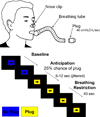Under pressure: adolescent substance users show exaggerated neural processing of aversive interoceptive stimuli
- PMID: 26234745
- PMCID: PMC4644498
- DOI: 10.1111/add.13090
Under pressure: adolescent substance users show exaggerated neural processing of aversive interoceptive stimuli
Abstract
Aims: Adolescents with substance use disorders (SUD) exhibit hyposensitivity to pleasant internally generated (interoceptive) stimuli and hypersensitivity to external rewarding stimuli. It is unclear whether similar patterns exist for aversive interoceptive stimuli. We compared activation in the insular cortex and other brain regions during the anticipation and experience of aversive stimuli between adolescents with SUD and those without.
Design: Cross-sectional experimental study with two groups.
Participants: Adolescents (ages 15-17 years) with an alcohol or marijuana SUD (n=18) and healthy comparison subjects (CON, n=15). Participants were recruited by distributing flyers at local high schools.
Setting: Keck Imaging Center, University of California San Diego, CA, USA.
Measurements: Behavioral and neural responses to a continuous performance task with inspiratory breathing load recorded during an fMRI session. Questionnaires assessed life-time drug use, anxiety, sensation-seeking, impulsivity, affect and bodily awareness. Visual analog scales assessed drug craving and breathing load responses.
Findings: Across subjects, experience of breathing load elicited greater bilateral anterior and posterior insula (AI and PI, respectively) activation than anticipation (F(1,31)=4.16, P<0.05). SUD exhibited greater left AI and bilateral PI activation during breathing load than anticipation, compared with CON (F(1,31)=4.16, P<0.05). In contrast, CON showed greater activation during anticipation than breathing load in left PI, compared with SUD (F(1,31)=4.16, P<0.05).
Conclusions: Adolescents with alcohol and marijuana substance use disorders may be hypersensitive to aversive interoceptive stimuli.
Keywords: Adolescence; alcohol; breathing load; cannabis; fMRI; interoception.
© 2015 Society for the Study of Addiction.
Conflict of interest statement
All authors declare that they have no conflict of interest.
Figures





References
-
- Johnston LD, O'Malley PM, Bachman JG, Schulenberg JE, Miech RA. Monitoring the Future National Survey Results on Drug Use, 1975–2013. 2014 May 30;:1–659.
-
- Anthony JC, Petronis KR. Early-onset drug use and risk of later drug problems. Drug Alcohol Depend. 1995 Nov;40(1):9–15. - PubMed
-
- Grant BF, Stinson FS, Harford TC. Age at onset of alcohol use and DSM-IV alcohol abuse and dependence: a 12-year follow-up. J Subst Abuse. 2001;13(4):493–504. - PubMed
-
- Bonomo YA, Bowes G, Coffey C, Carlin JB, Patton GC. Addiction. 12. Vol. 99. Blackwell Science Ltd; 2004. Dec, Teenage drinking and the onset of alcohol dependence: a cohort study over seven years; pp. 1520–1528. - PubMed
-
- Grant JD, Scherrer JF, Lynskey MT, Lyons MJ, Eisen SA, Tsuang MT, et al. Psychol Med. 1. Vol. 36. Cambridge University Press; 2006. Jan, Adolescent alcohol use is a risk factor for adult alcohol and drug dependence: evidence from a twin design; pp. 109–118. - PubMed
Publication types
MeSH terms
Substances
Grants and funding
LinkOut - more resources
Full Text Sources
Other Literature Sources
Medical
Research Materials
Miscellaneous

